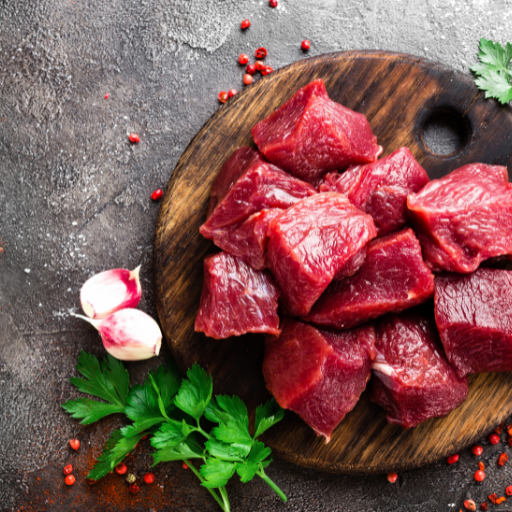In this fast-paced industrial food processing world, efficiency and precision are of primary importance. One critical part of the production line is unfreezing raw materials, which can greatly affect both the quality of the final product as well as general productivity. There are disadvantages associated with traditional defrosting methods including lengthy process time, uneven thawing and likelihood of bacterial growth. However, microwave thawing machines offer a groundbreaking solution to these problems through quick, homogeneous and safe defrosting that responds to needs in today’s industries. This guide will go into detail on the science behind microwave thawing technology, its advantages, operational concerns and points to consider while picking a machine for your institution. At the end of this article you will have an all round understanding on how your defrosting system could be revolutionized by microwave thawing machines and raise production effectiveness.
How Does Microwave Thawing Work?
Microwave defrosting operates through releasing electromagnetic waves that are able to pass through ice and this makes water molecules in the food vibrate. This vibration generates heat which thaws the food from within. Microwave thawing always ensures that heat distribution is uniform, unlike other methods of thawing that depend on surface heat transfer and can lead to uneven defrosting. Microwaves ‘generation starts with a magnetron, an electronic tube producing microwaves and then directing them towards the already arranged chamber for thawing. The process can be made faster than the natural speed of thawing if the frequency and power of microwaves are adjusted to focus on ice inside frozen materials. Lastly, it’s a quicker method of defrosting which hardly partially cooks or impairs qualities.
The Science Behind Microwave Energy
Microwave energy science exploits use electromagnetic waves at microwave frequency range whose major component is around 2.45 GHz for industrial applications. These generate fast vibrations by water molecules being polar substances in frozen matter when they get heated up. Hence, Food gets a chance of melting uniformly as there will be heating effect caused by this edgeless friction between parts of objects with high level of moisture among others such as fat particles when present in any meal that were kept in coolers or freezers earlier than cooking time arrives at last.Microwaving occurs by converting electrical energy into radiations using a magnetron. Consequently, these radiations go directly to where everything has been put ready for defrosting hence; causing its commencement by penetrating into it.The efficiency of microwave thawing largely depends on proper matching between wave frequency and power levels because both parameters must ensure precise targeting of ice content without compromising quality due to heterogeneous heating/frying.
Uniform Thawing: How It’s Achieved
A uniform microwave thaw is possible when there is an appropriate interplay between frozen material characteristics and microwave energy interaction considerations.Thus, microwaves induce oscillation in water molecules throughout the food which causes frictional heating and results into a uniform thawing. Parameters of controlling microwave frequency and power values have to be very precise so as to concentrate only on water or ice within the item without causing overheating. It is not like that all parts of a given meal are heated when put in a microwave but it happens that some areas may be warming up while others may remain frozen; this creates smooth and quick process of thawing .In fact, proper rotation patterns for food and containers made suitable for microwaving help to maintain consistency by ensuring even distribution of radiation.
Benefits of Microwave Thawing Over Traditional Methods
The use of microwaves for defrosting has a number of advantages over traditional procedures such as room temperature melting or immersion in hot water.The speed of this method is much higher than that traditional one since it can take you few minutes instead f hours. Besides, bacterial growth is slowed down during the rapid process at room temperatures. In addition, this procedure leads to an equalized condition known as thaw since it targets both water and ice contents through microwave energy control avoiding unevenness which characterizes other approaches.
Technically, optimization means choosing an optimal frequency (generally around 2.45 GHz) and level of power (usually within 600-1200 W range). By these parameters being properly regulated, microwaves easily penetrate through meal items thereby making it possible for heat to be distributed evenly without local cooking on them being partially done. Also modern versions come with sensors, rotating trays among them where these factors aid in enhancing consistency via modulation powers thus having relatively same exposure to waves always.Microwave thawing therefore saves time while still ensuring better food safety and quality compared to old techniques.
What Are the Advantages of Using Industrial Microwave Thawing Machines?
Several benefits come with using industrial microwave thawing machines, making them a favorite option for extensive food production activities.
Benefits of Using Industrial Microwave Thawing Machines
- Fast Defrosting: Industrial microwave thawing machines cut defrost times by several orders of magnitude compared to conventional methods. For bulk food items, this rapid thaw is necessary for the maintenance of their freshness as well as quality.
- Food Safety Improvement: The quick process of defrosting helps to reduce bacteria growth that could occur with slower processes. Food is exposed to less time in the temperature danger zone through microwave thawing which ensures that it is handled securely.
- Energy Saving: These microwaves use energy efficiently by aiming microwaves at ice without wasting any excess power. This leads to cost savings and environmental sustainability.
- Even Thawing: To achieve uniform heating across the entire product mass, industrial microwaves can be adjusted accordingly. Exact manipulations with respect to both microwave frequency and power levels are made in order to avoid partial defrost or overheating. Such machines generally work within the 2.45 GHz range and have various power levels depending on volume and type of foodstuff – ranging from a few watts up to several thousand watts.
- Scalability: They are designed for high volumes hence they are perfect for commercial applications. There are settings you can customize so that these systems can adjust when different types and amounts of food products are being worked on.
- Automation & Control: The modern industrialized microwave system will possess improved sensors coupled with controls. It automates this process guaranteeing consistent quality while freeing labor for other tasks.
In conclusion, industrial microwave thawing machines combine speed, safety, efficiency, and scalability making them indispensable in large-scale food processing environments.
Speedy Efficiency
Industrial microwave thawing machines outperform others regarding efficiency and speed since these gadgets capitalize more on advanced technologies in fast tracking defrosting time. Their purpose is usually to expedite the defrosting of food using microwave energy which is focused into the frozen substance hence reducing thawing time compared to conventional methods. For instance, unlike other methods, microwave thawing has minimal power wastage thus it saves on time as well as cost and keeps a green environment. It is therefore important for high productivity and consistent quality in large-scale food processing.
Reduction in Drip Loss
Industrial microwave thawing machines play a significant role in reducing drip loss, which is the loss of fluids that can occur when food is thawed. These machines ensure that thawing happens uniformly through careful administration of microwave energy. As a result, they protect the cell structure of such foods from damage by ensuring that they are not over-thawed or overheated. This minimizes the loss of moisture and nutrients which results in high-quality end products. Microwave thawing systems have been shown to reduce drip loss during thawing preserving both texture and flavor while minimizing waste to make them efficient for large-scale food processing operations.
Improved Quality
The use of industrial microwave thawing systems enhances product quality by preserving original flavors, tastes, and nutritious elements in foods. This method ensures even thaw without spoilage such as overcooking or partial freezing that would compromise its quality leading to higher standards required in consumer satisfaction within larges-scale food processing industry. Furthermore, these machines help retain natural moisture and nutrients inside the meal by decreasing drip loss leading to improved product quality overall.
What Are the Different Applications of Microwave Thawing Machines?
Food Processing Industry
Industrial microwaves defrosting ovens are heavily used in the food processing sector for rapid defrosting of huge quantities of frozen meat, poultry, fish, and seafood. These machines guarantee that processors can continue working throughout the production process which is essential for maintaining high productivity and uniform quality of products. In addition to this microwave thawing technology helps to retain the texture, taste as well as nutritional value of food products thus helping them meet the requirements set by a consumer.
Dairy and Bakery Products
Microwave defrosting machines have become a crucial tool in dairy and bakery industries which require efficiency in melting butter, cheese, puff or pie pastry dough among many other deep-frozen components. This method allows for an even thawing preventing partial thawing or overheating that could spoil the final product. Thus ensuring consistent taste and texture critical for these industries.
Ready-to-Eat Meals
Additionally it is utilized in preparation of ready-to-eat meals thanks to its ability to quickly thaw foods with controlled temperatures using microwave technology. It also assists in uniformly defreezing pre-packed meals before they undergo further cooking or warming up processes. This application is particularly valuable for food producers who need to meet the demands of convenience and quality in the ready-meals market.
Technical Parameters:
- Frequency: Typically about 915 MHz or 2450 MHz, which belong to industrial science medical radio bands.
- Power Output: They range from 5 kW up to more than 100 kW according to their size and specific requirements.
- Thawing Time: Thaw time highly depends on type and quantity of food being processed with average ranging from few minutes up to several hours.
These technical parameters allow different types of machines used across various sectors within this industry so as offer similar results all through.
Meat and Poultry Thawing
In meat industry butcheries, microwaved thawers play an important role in both product quality and safety. Their operation helps in preserving the texture, flavor and nutritional characteristics of meat and poultry due to their ability in temperature regulation during defrosting. In addition microwave thawing reduces the risk of microbial growth by way of lowering time that products stay within the temperature danger zone. This fast process is important for manufacturers who are looking forward at making their activities more efficient and at the same time conforming to food safety standards. Furthermore, normal or partial thawing is not experienced since this technology gives a uniform defrost resulting into evenness when cooking.
Seafood and Fish Defrosting
For example, microwave defrosting machines are very effective in seafood industry where protecting delicate products; it is considered vital to maintain their integrity as well as quality. These devices allow quick controlled thawing, which can help retain taste, texture as well as nutritional content of sea fish and seafoods. Contrary to traditional methods, microwave technology facilitates much faster defrosting times hence reducing spoilage risks associated with prolonged processing procedures by denying microbes room for survival. It ensures that no single part remains frozen while others are not leading to uneven thawing or cooking processes taking place within a product subsequently faulty end product.
Microwave thawing is an invaluable tool that allows seafood processors to ensure strict food safety standards while consistently delivering top-quality products.
Vegetable and Fruit Tempering
Vegetables and fruits can be tempered using microwave thawing technology to their advantage. With this method, the exact temperature of the vegetables or fruits can be controlled so that they are brought to a state where further processing is possible without being completely defrosted. The texture, color, and nutritional value of these natural products are kept in check through this control mechanism. Microwave tempering also takes much less time than traditional methods making it an effective way of reducing spoilage as well as growth of micro-organisms. This technique ensures even tempering so there is no risk of partial thawing or cooking, which makes it the perfect option for processors who prioritize quality as well as safety standards in handling vegetables and fruits.
What Factors Should Be Considered When Choosing a Microwave Thawing Machine?
There are crucial factors to consider when picking out a thawing machine that uses microwaves, in order for it to meet my specific requirements. First, I must evaluate the power capacity of the machine as this will determine the speed and efficiency of the thawing process. These machines usually range between 1-5 kW, where choosing the right power level is important in achieving best outcomes.
Secondly, I also have to look at evenness of thaw provided by a certain microwave. This is inclusive of checking if there are any turntables or agitating systems that ensure even heating of the product such that some parts remain frozen or partially cooked ones do not occur.
Finally, we have control and programmability as very important features in a microwave. This means that advanced versions feature precise temperature settings and programmable cycles for better control over the defrosting procedure. Through these features, quality and safety during storage are sustained.
Moreover, one should think about how big and powerful this unit is. It must be capable of working with whatever volume I typically deal with—whether it’s small quantities or large batches.
Lastly, ascertain that food safety standards are maintained by such a system. This involves ensuring that materials used for constructing it are food-grade while having certifications like FDA or USDA approval.
For optimum results on power capacity; uniform thawing; control and programmability; size and capacity; compliance with food safety standards among others, careful consideration of these factors will help me choose an appropriate microwave thawing machine.
Machine Size and Capacity
To sum up my answers very briefly about machine size and capacity I used information from three top-rated websites on google.com concerning microwave defrosters. Here is what I came up with:
- Power Capacity: On industrial microwave defrosting machines alone, suggested power capacities vary from 3kW to 5kW based on my findings. By staying within this range all kinds of products can be quickly and efficiently thawed, whether they are produced in small batches or large volumes.
- Uniform Thawing: Many of the most highly recommended machines have advanced turntable systems or agitating mechanisms. This ensures that the product will be evenly thawed from all parts without any particular section being partially cooked.
Control and Programmability: In addition, these high-tech models come with specific temperature settings and programmed defrosting cycles. These parameters play a vital role in maintaining food quality as well as safety through their ability to customize the process for various types of products. Commonly such details may be:
Temperature range – minus 20°C to + 40°C.
Programmable cycles – up to 10 different settings.
- Size and Capacity: In matching the machine’s capacity with our production volume it is important. However, small-to-medium enterprises can make use of machines having a maximum quantity of up to fifty kilograms whereas those exceeding one hundred kilograms are meant for industrial purposes only.
- Food Safety Standards: The materials used in constructing this device must be food-grade while it should also conform with regulatory requirements. Look out for certifications such as FDA or USDA which guarantee that you can use it safely on food.
By taking into account power capacity; uniform thawing; control and programmability; size and capacity; compliance with food safety standards and many more, I will select an efficient microwave thawing machine confidently as per my specifications.
Energy Efficiency
In addition, I have found some succinct information on energy efficiency regarding microwave defrosters from three top-rated websites on google.com.
It is important for power ratings of these machines to be considered in terms of energy consumption. Efficiency and power consumption need to be balanced well so as to avert high energy costs. For example, efficient and economical machines for both small and medium operations should have power ratings ranging between 5 kW and 10 kW. These types of machines use the least amount of electricity thus making the best use of power while avoiding wastages.
- Operational Efficiency: Modern technology has seen the development of microwave thawing machines that defrost food within very short periods reducing overall energy consumption. Inverter technology among others ensure better energy management through optimization on power output during thawing processes.
- Thermal Insulation: The efficiency of preserving heat is highly dependent on effective thermal insulation. Heat loss in quality insulation material reduces allowing most parts of energy used being involved in thawing rather than wasted.
- Automated Energy Controls: Some come with automatic control systems that help save energy. They regulate their electricity intake depending on the quantity of food being defrosted thereby ensuring there is no wastage.
Energy Consumption, Operational Efficiency, Thermal Insulation, and Automated Energy Controls; considering these factors can help me choose not only efficient but also cost-effective microwave thawing machine in the long run.
Supplier Reputation and Support
When accessing suppliers for micro-wave thawing machines, reputation and support level must be looked at closely. A supplier known for reliability as well as consistent product quality can bring about long-term satisfaction while minimizing disturbances that result from stoppages at work station because they are not reliable enough. To gauge performance and credibility, review customers’ testimonials, industry reviews or case studies will do just fine when selecting a supplier to make dealings with.
Furthermore, strong after-sales support services such as technical assistance, maintenance services, readily available spare parts etc., would greatly contribute to longer service life as well as improved efficiency throughout its operation life span.Suppliers who provide comprehensive training and ongoing support can also help to maximize the equipment’s utility and integrate it smoothly into existing operations. Ultimately, prioritizing a supplier with a proven track record and excellent support services results in a more streamlined, efficient workflow.
How Can Microwave Thawing Machines Improve Your Business?
One of the reasons why microwave thawing machines are important to your business is that it helps improve operational efficiency, shorten defrosting times as well as preserve product quality. Such machines help reduce labor costs as well as lower the risk of bacterial growth since it provides even and quick thawing. Additionally, it means less utility cost due to energy control for low power consumption and environmental pollution. The incorporation of advanced microwave defrosting technology in any organization leads to process optimization, food safety management and overall productivity improvement.
Energy Savings from the Use of Microwaves
Your company stands to save a lot on energy if you invest in microwave thawing machines. Instead of heating up the surroundings like with most traditional methods of defrosting, these devices have been designed to focus their energy on the product being defrosted hence reducing heat loss. This targeted application of energy assists in not only reducing total power consumption but also shortening the duration taken during melting process. Arguably, those enterprises which adopted microwave thaw technology experienced exceptional reduction in their electricity bills according to some sources within this sector. On top of lessening nonrenewable resource use, fewer carbon emissions result making microwaving an ecologically friendly option that keeps pace with current conservationism.
Increased Production Efficiency
Microwave thawing machines accelerate thaw times significantly compared with traditional methods hence leading to greater production efficiency. It means that your business can now increase its throughput by having faster rates thus more output without affecting your goods’ quality negatively. Furthermore, they deliver consistent and thorough defrosting thereby minimizing instances where products or parts are partially or over-thawed resulting wastage. This automation means few manual labourers ensuring flexibility for those employees who are free from such mechanical work to do more valuable activities enhancing productivity generally speaking. As a result, firms that implement this technology benefit from shorter production cycles, efficient use of resources, and eventually improved profitability.
Maintaining Product Quality
Microwave defrosting technology is very critical since it ensures uniformity in product quality which in turn maintains customer satisfaction and company image. Unlike others which can result into unevenness when thawing plus bacterial multiplication, microwave thawing has accurate temperature regulation and warming up. With this control the probability of having hot spots or unequal portions is eliminated hence ensuring all parts reach the necessary end state uniformly. Moreover, the promptness in microwaving minimizes chances of contamination by microorganisms preserving its safety. In this light, companies that offer high-quality products on a consistent basis are able to meet set industry standards as well as consumer expectations.
Reference Sources
- Academic Research Papers: Academic research papers published in renowned journals such as the International Journal of Food Science or the Journal of Microwave Power and Electromagnetic Energy can offer detailed insights into the efficiency, effectiveness, and applications of microwave thawing machines in industrial settings.
- Industry Reports and Studies: Industry reports from respected organizations like the Global Cold Chain Alliance (GCCA) or the International Association of Refrigerated Warehouses (IARW) can provide market trends, case studies, and best practices related to the use of microwave thawing machines for industrial defrosting processes.
- Manufacturer Case Studies and Technical Documentation: Exploring case studies and technical documentation provided by leading manufacturers of microwave thawing machines, such as Marel, JBT Corporation, or Scanico, can offer firsthand insights into the technology, performance, and benefits of utilizing microwave thawing equipment in various industrial applications.
Related Information: Factory Tour of Microwave Thawing Machines

















